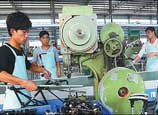
There has already been close cooperation between the US and the EU, and the lowering of trade and investment barriers will tend to increase merchandise and capital flows between the two, which will bring side effects to external players such as China.
In addition, both the US and EU have been seeking to build new trade rules through regional trade arrangements. Although China has entered into the inner circle of world trade, it has limited power in setting rules, and the new conditions related to environment, labor and so on will pose further challenges.
The US-EU FTA talks will most likely be protracted, due to differences in trade regimes and many technical hurdles. Nonetheless, China cannot just look on, but needs to make early preparations.
China should actively promote FTA negotiations according to its own agenda.
Currently, China's trade volume with its Asian partners is more than that with the US and EU combined. China's primary trade arrangement should be done with its neighbors.
China needs to actively promote the FTA with Japan and South Korea, and the Regional Comprehensive Economic Partnership with ASEAN countries.
In this way, China could not only benefit from more market access, but also gain leverage for ultimate multilateral trade negotiations with the US and EU in the future.
China should also seize the chance to encourage more Chinese firms to invest in the US and the EU.
In recent years, trade protectionism has been on the rise in the US and the EU, but Chinese enterprises like Haier and Wanxiang, which ensured an early footprint there are not afraid of such barriers.


















 China's 'leftover women' phenomenon arouses heated debate in West
China's 'leftover women' phenomenon arouses heated debate in West


![]()
